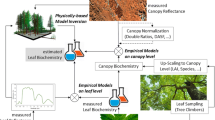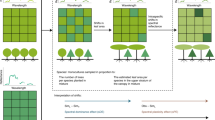Abstract
We report a multiscale study in the Wind River Valley in southwestern Washington, where we quantified leaf to stand scale variation in spectral reflectance for dominant species. Four remotely sensed structural measures, the normalized difference vegetation index (NDVI), cover fractions from spectral mixture analysis (SMA), equivalent water thickness (EWT), and albedo were investigated using Airborne Visible Infrared Imaging Spectrometer (AVIRIS) data. Discrimination of plant species varied with wavelength and scale, with deciduous species showing greater separability than conifers. Contrary to expectations, plant species were most distinct at the branch scale and least distinct at the stand scale. At the stand scale, broadleaf and conifer species were spectrally distinct, as were most conifer age classes. Intermediate separability occurred at the leaf scale. Reflectance decreased from leaf to stand scales except in the broadleaf species, which peaked in near-infrared reflectance at the branch scale. Important biochemical signatures became more pronounced spectrally progressing from leaf to stand scales. Recent regenerated clear-cuts (less than 10 years old) had the highest albedo and nonphotosynthetic vegetation (NPV). After 50 years, the stands showed significant decreases in albedo, NPV, and EWT and increases in shade. Albedo was lowest in old-growth forests. Peak EWT, a proxy measure for leaf area index (LAI), was observed in 11- to 30-year-old stands. When compared to LAI, EWT and NDVI showed exponentially decreasing, but distinctly different, relationships with increasing LAI. This difference is biologically important: at 95% of the maximum predicted NDVI and EWT, LAI was 5.17 and 9.08, respectively. Although these results confirm the stand structural variation expected with forest succession, remote-sensing images also provide a spatial context and establish a basis to evaluate variance within and between age classes. Landscape heterogeneity can thus be characterized over large areas—a critical and important step in scaling fluxes from stand-based towers to larger scales.








Similar content being viewed by others
References
JB Adams MO Smith AR Gillespie (1993) Imaging spectrometry: interpretation based on spectral mixture analysis CM Pieters P Englert (Eds) Remote geochemical analysis: elemental and mineralogical composition; vol 7 Cambridge University Press New York p 145–166
GP Asner (1998) ArticleTitleBiophysical and biochemical sources of variability in canopy reflectance Remote Sens Environ 64 234–53 Occurrence Handle10.1016/S0034-4257(98)00014-5
A Berk LS Bernstein DC Robertson (1989) MODTRAN: a moderate resolution model for LOWTRAN 7. Final Report GL-TR-0122 AFGL Hanscom AFB, MA. 42 p
Chen J, Paw U KT, Ustin SL, Suchanek TH, Falk M, Brosofske KD, Wang X, and others. 2004. Net ecosystem exchanges of carbon, water, and energy in young and old-growth Douglas-fir forests. Ecosystems 7:
WB Cohen TA Spies (1992) ArticleTitleEstimating structural attributes of Douglas-fir/western hemlock forest stands from Landsat and SPOT imagery Remote Sens Environ 41 1–17 Occurrence Handle10.1016/0034-4257(92)90056-P
WB Cohen TA Spies GA Bradshaw (1990) ArticleTitleSemivariograms of digital imagery for analysis of conifer canopy structure Remote Sens Environ 34 167–78 Occurrence Handle10.1016/0034-4257(90)90066-U
WB Cohen TA Spies FJ Swanson DO Wallin (1995) ArticleTitleLand cover on the western slopes of the central Oregon Cascade range Int J Remote Sens 20 IssueID3 421–35
CD Elvidge (1990) ArticleTitleVisible and near-infrared reflectance characteristics of dry plant materials Int J Remote Sens 11 IssueID10 1775–95
Franklin JF, Spies TA, Van Pelt R, Carey AB, Thornburgh DA, Berg DR, Lindenmayer DB, and others. 2002. Disturbances and structural development of natural forest ecosystems with silvicultural implications, using Douglas-fir forests as an example. For Ecol Manage 155(N1–3)SI:399–423.
GW Frazer JA Trofymow KP Lertzman (2000) ArticleTitleCanopy openness and leaf area in chronosequences of coastal temperate rainforests Can J For Res 30 IssueID2 239–56 Occurrence Handle10.1139/cjfr-30-2-239
Gamon JA, Field CB, Goulden ML, Griffin KL, Hartley AE, Geeske J, Penuelas J, and others. 1994. Relationship between NDVI, canopy structure, and photosynthesis in three California vegetation types. Ecol Appl 5(1):28–41.
DM Gates HJ Keegan JC Schleter VR Weidner (1965) ArticleTitleSpectral properties of plants Appl Optics 4 IssueID1 11–20
HW Gausman (1985) Plant leaf optical properties in visible and near-infrared light. Graduate Studies Texas Tech University No. 29 Texas Tech Press Lubbock (TX) 78
P Gong RL Pu JR Miller (1995) ArticleTitleConiferous forest leaf area index estimation along the Oregon Transect using compact airborne spectrographic imager data Photogram Eng Remote Sens 61 IssueID9 1107–17
SN Goward KF Huemmrich RH Waring (1994) ArticleTitleVisible-near-infrared spectral reflectance of landscape components in western Oregon Remote Sens Environ 47 IssueID2 190–203 Occurrence Handle10.1016/0034-4257(94)90155-4
RO Green JE Conel JS Margolis CJ Bruegge GL Hoover (1991) An inversion algorithm for retrieval of atmospheric and leaf water absorption from AVIRIS radiance with compensation for atmospheric scattering RO Green (Eds) Proceedings of the 3rd Airborne Visible/Infrared Imaging Spectrometer (AVIRIS) Workshop. 20–21 May Jet Propulsion Laboratory Pasadena, CA, USA p 51–61
Green RO, Conel JE, Roberts DA. 1993. Estimation of aerosol optical depth and calculation of apparent surface reflectance from radiance measured by the airborne visible-infrared imaging spectrometer (AVIRIS) using MODTRAN2. SPIE Conference 1937: Imaging Spectrometry of the Terrestrial Environment, Greg Vane, Orlando, FL, 14–15 April 1993; The International society for Optical Engineering (SPIE), Bellingham, WA, p 2–5.
Green RO, Eastwood ML, Sarture CM, Chrien TG, Aronsson M, Chippendale BJ, Faust JA, and others. 1998. Imaging spectroscopy and the airborne visible infrared imaging spectrometer (AVIRIS). Remote Sens Environ 65(3):227–48.
PE Heilman TM Hinckley DA Roberts R Ceulemans (1996) Production physiology RF Stettler HW Bradshaw PE Heilman TM Hinckley (Eds) Biology of Populus and its implications for management and conservation NRC Research Press Washington (DC) 459–490
LF Johnson CA Hlavka DL Peterson (1994) ArticleTitleMultivariate analysis of AVIRIS data for canopy biochemical estimation along the Oregon Transect Remote Sens Environ 47 216–30 Occurrence Handle10.1016/0034-4257(94)90157-0
BE Law RH Waring (1994a) ArticleTitleRemote sensing of leaf area index and radiation intercepted by understory vegetation Ecol Appl 4 272–9
BE Law RH Waring (1994b) ArticleTitleCombining remote sensing and climatic data to estimate net primary production across Oregon Ecol Appl 4 717–28
MA Lefsky WB Cohen SA Acker GC Parker TA Spies D Harding (1999) ArticleTitleLidar remote sensing of the canopy structure and biophysical properties of Douglas-fir western hemlock forests Remote Sens Environ 70 IssueID3 339–61 Occurrence Handle10.1016/S0034-4257(99)00052-8
MJ Mariscal SN Martens SL Ustin J Chen SB Weiss DA Roberts (2004) ArticleTitleLight transmission profiles in an old-growth forest canopy: Simulations of photosynthetically active radiation using spatially explicit radiative transfer models Ecosystems 7 .–.
JE Means SA Acker DA Harding JB Blair (1999) ArticleTitleUse of large-footprint scanning airborne lidar to estimate forest stand characteristics in the western cascades of Oregon Remote Sens Environ 67 298–308 Occurrence Handle10.1016/S0034-4257(98)00091-1
CD Oliver BC Larson (1990) Forest stand dynamics McGraw-Hill New York 467
DL Peterson RH Waring (1994) ArticleTitleOverview of the Oregon Transect ecosystem research project Ecol Appl 4 IssueID2 211–25
DL Peterson MA Spanner SW Running KB Teuber (1987) ArticleTitleRelationship of thematic mapper simulator data to leaf area index of temperate coniferous forests Remote Sen Environ 22 323–4 Occurrence Handle10.1016/0034-4257(87)90087-3
CS Potter JT Randerson CB Field PM Matson PM Vitousek HA Mooney SA Klooster (1993) ArticleTitleTerrestrial ecosystem production: a process model based on global satellite and surface data Global Biogeochem Cycles 7 811–41
DA Roberts RO Green JB Adams (1997) ArticleTitleTemporal and spatial patterns in vegetation and atmospheric properties from AVIRIS Remote Sens Environ 62 223–40 Occurrence Handle10.1016/S0034-4257(97)00092-8
Roberts DA, Brown KJ, Green R, Ustin S, Hinckley T. 1998a. Investigating the relationship between liquid water and leaf area in clonal Populus. In: Green RO, editor. Proceedings of the 7th AVIRIS Earth Science Workshop. Jet Populsion Laboratory 12–16 Jan 1998, Pasadena, CA, USA. p 335–344.
DA Roberts G Batista J Pereira E Waller B Nelson (1998b) Change identification using multitemporal spectral mixture analysis: applications in eastern Amazonia C Elvidge R Lunetta (Eds) Remote sensing change detection: environmental monitoring applications and methods Ann Arbor Press Ann Arbor (MI) p 137–61
BN Rock DL Williams DM Moss GN Lauten M Kim (1994) ArticleTitleHigh-spectral resolution field and laboratory optical reflectance measurements of red spruce and eastern hemlock needles Remote Sens Environ 47 176–89 Occurrence Handle10.1016/0034-4257(94)90154-6
SW Running (1994) ArticleTitleTesting forest-BGC ecosystem process simulations across a climatic gradient in Oregon Ecol Appl 4 IssueID2 238–47
DE Sabol AR Gillespie JB Adams MO Smith CJ Tucker (2002) ArticleTitleStructural stage in Pacific Northwest forests estimated using simple mixing models of multispectral images Remote Sens Environ 80 IssueID1 1–16 Occurrence Handle10.1016/S0034-4257(01)00245-0
PJ Sellers (1985) ArticleTitleCanopy reflectance, photosynthesis and transpiration Int J Remote Sens 6 1335–72
Sellers PJ, Randall DA, Collatz CJ, Berry JA, Field CB, Dazlich DA, Zhang C, and others. 1996. A revised land surface parameterization (SiB2) for atmospheric GCMs. Part 1. Model formulation. J Clim 9:676–705.
DC Shaw JF Franklin K Bible J Klopatek E Freeman S Greene GG Parker (2004) ArticleTitleEcological setting of the Wind River old-growth forests Ecosystems 7 .–.
MO Smith SL Ustin JB Adams AR Gillespie (1990) ArticleTitleVegetation in deserts. I. A regional measure of abundances from multispectral images Remote Sens Environ 29 1–26 Occurrence Handle10.1016/0034-4257(90)90074-V
MA Spanner L Johnson J Miller R McCreight J Freemantle J Runyon P Gong (1994) ArticleTitleRemote sensing of seasonal leaf area index across the Oregon Transect Ecol Appl 4 IssueID2 258–71
TH Suchanek HA Mooney JF Franklin H Guckinski SL Ustin (2004) ArticleTitleCarbon dynamics of an old-growth forest Ecosystems 7 .–.
SC Thomas WE Winner (2000) ArticleTitleA rotated ellipsoidal angle density function improves estimation of foliage inclination distributions in forest canopies Agric For Meteorol 100 19–24 Occurrence Handle10.1016/S0168-1923(99)00089-1
CJ Tucker (1979) ArticleTitleRed and photographic infrared linear combinations for monitoring vegetation Remote Sens Environ 8 127–50 Occurrence Handle10.1016/0034-4257(79)90013-0
DL Williams (1991) ArticleTitleA comparison of spectral reflectance properties at the needle, branch and canopy level for selected conifer species Remote Sens Environ 35 79–93 Occurrence Handle10.1016/0034-4257(91)90002-N
JT Woolley (1971) ArticleTitleReflectance and transmittance of light by leaves Plant Physiol 47 656–62
Acknowledgments
We thank Dr. Jeff Dozier for the loan of an ASD spectrometer for the 1999 field campaign, Edward Collins for Modtran simulations used for albedo calculations, Dr. David Shaw for collecting the nonvascular epiphytes from the WRCCRF, and George J. Scheer for measuring the epiphyte spectra. AVIRIS data used in this study were supplied by the NASA Jet Propulsion Laboratory, which also supplied an ASD field spectrometer in 1996. Access to the WRCCRF was kindly supplied by the USDA Forest Service Pacific Northwest station, which also facilitated research in the area. Funding for this research was supported by the Office of Science (BER), US Department of Energy, through the Western Regional Center of the National Institute for Global Environmental Change under cooperative agreement no. DE-FC03-90ER61010. Finally, we thank two independent reviewers and Dr. Steven Seagle for helpful comments on the manuscript. Any opinions, findings, and conclusions or recommendations expressed herein are those of the authors and do not necessarily reflect the view of the DOE.
Author information
Authors and Affiliations
Rights and permissions
About this article
Cite this article
Roberts, D., Ustin, S., Ogunjemiyo, S. et al. Spectral and Structural Measures of Northwest Forest Vegetation at Leaf to Landscape Scales. Ecosystems 7, 545–562 (2004). https://doi.org/10.1007/s10021-004-0144-5
Received:
Accepted:
Published:
Issue Date:
DOI: https://doi.org/10.1007/s10021-004-0144-5




